Everything You Need To Know About Arnex Watches
Discover the story behind Arnex Watches & why they’re so desirable. Learn what to consider before buying one, and how to tell if it’s worth its price tag!
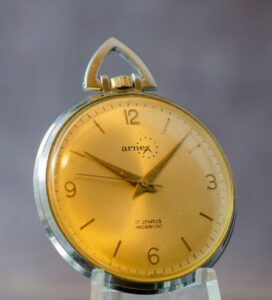
An early Arnex with the recognizable logo. Figure 1.
You found a used Arnex watch, consider it attractive, and think about buying it. Have you found any information to help you decide? Probably not and guess what? Many other people have the same concern because a couple of writers have written abou Arnex products, and their work lacks enough accuracy to become confusing. They unfortunately did not know their subject.
Is the watch worth what the seller has asked? How would anyone know? It becomes a head scratcher.
We compiled and wrote this article to assist buyers and sellers of Arnex products. Otherwise, we see stories or blog posts about the company with inaccurate information. Pose the question about the founder of Arnex in your search engine and it will provide the name of an employee named Claude Wollman instead of the actual founder, Arnold Fuchs, which I find unfortunate.
Arnex Products and Internet Marketplaces
Today, people find Arnex merchandize listed on eBay, Etsy, Poshmark and other ecommerce sites. During the 1970’s, the first modern resurgence of pocket watches emerged and Arnex cornered the market with Swiss creations. Arnex primarily sold their timepieces and accessories to jewelry and department stores.
Once again, we see people shopping for classics, and Asia has become the only source for new pocket watches with many people questioning Asian quality.
What to do?
One might consider Arnex because they have Swiss movements and quality cases. We see them listed and wonder who made them and few sellers actually know.
Resellers usually find Arnex products at estate sales but have little knowledge of their value. They wind the timepiece and promote them as working.
As a result, the listings contain extensive variances in price and identification. In addition, Sellers don’t know that 50-year-old Arnex movements typically need service. They seem like working timepieces, but all too often, they don’t run for more than a few weeks before a buyer will have to take them to a repair person.
This Article Can Help
We hope to contribute to consumer education given the documents we found, the many products we bought, examined and employees we interviewed.
After a search on the Internet about Arnex Industries, one finds many images, advertisements, claims of various kinds (including some that credit Claude Wollman as the founder of the company). Those writers say that he wanted to sell Swiss pocket watches to Americans., however, I believe we made an honest mistake in crediting him for that. I fact, he worked as an agent or employee for Arnex; a company founded around 1963 in New York by Arnold Fuchs.
Nine years after Fuchs started Arnex in the US, Claude Wollman formed Arnex SA because law required it. Wollman worked under a Swiss Joint Stock Company with a minimum capital of 50,000 Francs. Having a stated goal to ship to America, Arnex Industries Corp. of New York gave him permission to do that; then Wollman could also distribute the company’s catalogs to European Jewelers as American fashions migrated across the Atlantic. Wollman reported to the CEO of Arnex Industries in the United States. and worked as an employee for Arnex and reported to Arnold Fuchs. Wollman did not found Arnex.
Contradicting the claims that Wollman started Arnex, in 1972, Arnold Fuchs filed a stock offering with the SEC. In the Directory of Companies Filing Annual Reports with the Securities and Exchange Commission December 1972 Fuchs has a listing
Arnold Fuchs Sold Arnex in 1973
In 1973, Fuchs sold his corporation to Kidde & Company; therefore Arnex SA no longer served a purpose and Claude Wollman ceased to maintain it. On November 21, 1975, the Swiss Official Gazette of Commerce, struck Arnex SA from their roles (Article 89 ORC. SOGC, 7. 4. 1994, No. 67, p. 1856). Should a Swiss company fail to pay their registration fees, they can no longer conduct business.
During his tenure with Arnex, Claude Wollman had offices at Rue Hugi 32502 Biel/Bienne and he sent out catalogs from that location. Wollman maintained Arnex SA as his personal business while employed by the US Corporation whose main office distributed their catalogs from 48 West 48th Street, New York, NY.
What Do Seasoned Collectors Think?
Most collectors think of Arnex as a manufacturer, however, when Arnold Fuchs opened his business in New York City in October 1963, he only sold parts. He chose a location one block from the largest jewelry corridor in the world where he imported components watchmakers needed and his clients visited his business on foot.
In the 1960’s and 70’s, no one could find a more advantageous start-up location than New York’s Jewelry district. Most of the nation’s watchmakers worked in those 47th Street jewelry stores, and Fuchs provided much needed parts for imported movements and cases.

New York’s 47th Street Jewelry District Figure 2.Photo: Chris Ruvolo – Own work, CC BY-SA 4.0, https://commons.wikimedia.org/w/index.php?curid=3091295
The End of the US Watch Industry
Fuchs incorporated his fledgling business as Arnex Industries Corp., for which he used a logo consisting of the word “Arnex” together with the representation of a clock or face using the “X” in the name. He made his presence known among a few friends, and his company became busy from walk-in trade and by word of mouth.
In a September 2021 entry on the National Association of Watch and Clock Collectors forum, Dan Richter described Arnex’s business: “When I joined the company in 1970, the staff was 10 people. The business supplied parts such as movements, hands, cases, and dials to other small companies. We were (located) at 48 West 48th Street in Manhattan.”
In the 1960’s, electronic and quartz timepieces had yet to reach the marketplace. After World War II, men and women wore older mechanical wristwatches that needed frequent or at least annual service. Bulova, Hamilton, Elgin, Waltham, to mention a few, were offering older inventory made during the 1930’s to retail stores; meanwhile, companies like Arnex imported Swiss watches with modern movements.
A pocket watch craze re-emerged in the late 1960’s as Hollywood influenced men’s fashions.
During World War II, Franklin D. Roosevelt used the War Powers Act to convert the American watch industry from civilian to military use. After the war, the U.S. watch industry, once the world’s largest with a vast customer base, seemed spent. They had to retool, and some needed to raise capital; however, they didn’t make a comeback even with pent-up demand for new watches.
The Swiss had already positioned themselves as the leading source for the US retail market and American watch companies even bought Swiss movements.
Hamilton Watch Company could not survive on watchmaking alone after the war, thus, they diversified into metals. Don Sauers wrote, “The war had simply worn out much of Hamilton’s machinery. The Swiss, meanwhile, had developed. new, more sophisticated machinery and automated production techniques. It seemed to Hamilton management that it would be less expensive to import Swiss movements than to attempt to invest in new machinery and equipment.” (A Time for America, Page 181 Sauers, Sutter House, 1992.)
Pocket Watches had become scarce, and few people still used them. Train conductors and engineers carried timepieces on chains, but not many others did. Few watch brands offered them as wristwatches dominated the consumer and commercial markets after World War I. As a result, in the 1960’s, Switzerland controlled the watch industry and seemed poised to control it into the future.
Ironically, one of Arnex’s main suppliers, A. Huguenin Fils, S.A. of Bienne, became part of Hamilton Watch Company in 1959.
Three Piece Suits
Hollywood does influence the fashion industry, where film studios see fashion and costume designers as important to attracting audiences. We can date that impact back to the silent movie era when retailers began selling pleated skirts, sailor pants and other fashion items seen by actors in various roles. Western society obsesses over movie stars and what they wear.
A movie or a particular character can trigger a fashion trend when designs become nominated for various awards from the Academy of Motion Picture Arts and Science and gain widespread publicity. The 1967 film, Bonnie & Clyde, exemplifies this motion picture phenomenon as it resulted in a significant throwback to 1930’s fashions and that era’s gangster films.
Bonnie and Clyde received considerable publicity among newspaper and television critics as it became popular among audiences and achieved nominations and awards from the Golden Globes, the New York Film Critics, and others too numerous to mention. As a period-piece, it brought back the idea of three-piece suits, pocket watches and chains.



1970’s Style Three Piece Suits Figures 3-5 Drawings by Sam English
Following trends set in the 1920’s, the fashion industry began offering clothing styled after costumes seen in the 1967 film. Studios also saw merit in making films using the fashions seen in Bonnie & Clyde including Cabaret, The Sting & The Godfather (1972), and The Great Gatsby (1974).
Remember, Arnex Industries Corp. sold parts such as dials, hands, movements, main springs and so forth from 1963 to 1969 as well as a few watches.
Arnex Pocket Watches
What Really Changed?
Dan Richter wrote, “Among all those parts were three pocket watches: an open face 18.5’” with an enamel dial with a cow, a 16’” hunter case with a shield and a 16’” open face railroad watch. They turned out to be the right products at the right time. Three-piece suits became the fashion, and everyone wanted a pocket watch and a chain. Very quickly 10 people became about 120.” 2
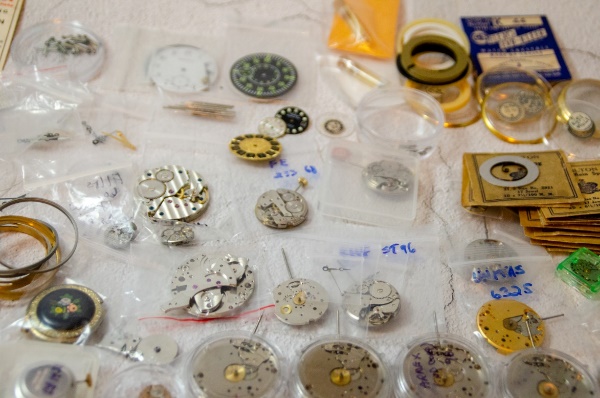
Watch Parts Figure 6
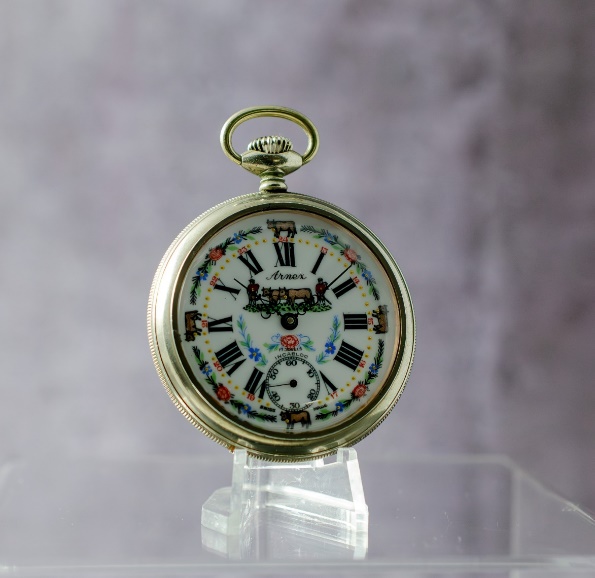

18.5 ligne3 Open Face Pocket Watch (model 26g) Figure 7. 16 ligne Railroad Watch Figure 8

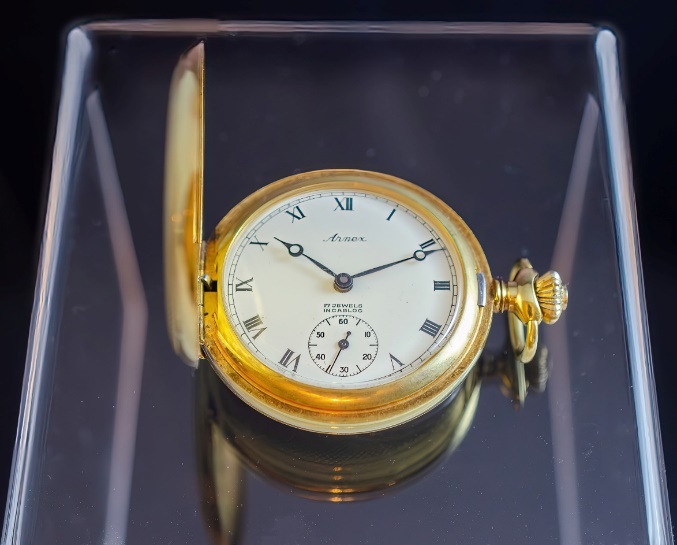
16 ligne flagship hunter case with a shield (model 14 g & w) Figures 9 & 10 (model 21w)
Pocket Watches Re-emerge in the 1970’s.
In his post of September 2021, Dan Richter mentioned two watches, which he later corrected to include three watches: an open face size 18.5 ligne with an enamel dial, a 16 ligne hunter case with a shield and a 16 ligne open face railroad watch.
To my knowledge, Hamilton Watch Company of Lancaster, PA offered a pocket watch after World War II, and they ceased production in 1969. Hamilton called it the “Traffic Special”, and it came with a Swiss Cortebert movement. Unfortunately for Hamilton, the last major name brand manufacturer of pocket watches missed the renewed demand created by Hollywood’s fashion and costume designers.
As word of Arnex offerings and their accessories spread, Arnold Fuchs changed the company’s name to Arnex Time Co., Inc. He gathered a collection of high-quality Swiss pocket watches and published a catalog. As Dan Richter implied, a small company of ten people grew to 120 in short order resulting in Arnex establishing itself as the main pocket watch supplier in the US. Even Sears, J.C. Penney and Montgomery Ward bought from Arnex who rebranded the watches for them.
In the 1970’s, the Internet did not exist, thus, eBay and Amazon did not exist. Stand alone retailers did not have a source for pocket watches or accessories. Who had pocket watches to sell and where could people find them?
Arnold Fuchs found manufacturers to produce pocket watches. As a result, Roventa Henex became Arnex Industries’ main supplier while others included Hebdomas, A. Huguenin Fils, S.A., Rollier, Cupillard, and Lorsa. Belair also made watches for Arnex in the United States from Swiss parts.
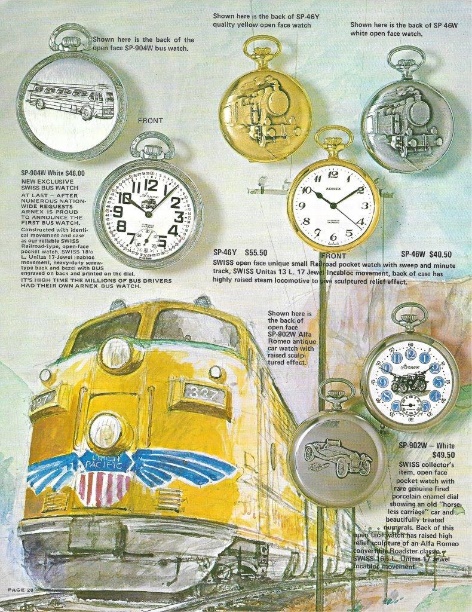
Right Time & Place For Arnex Pocket Watches
Before Arnex felt comfortable with wide distribution and product support, it attempted to market 21 different watches. It sent out four-page marketing brochures such as the one below. We found some of those early products.
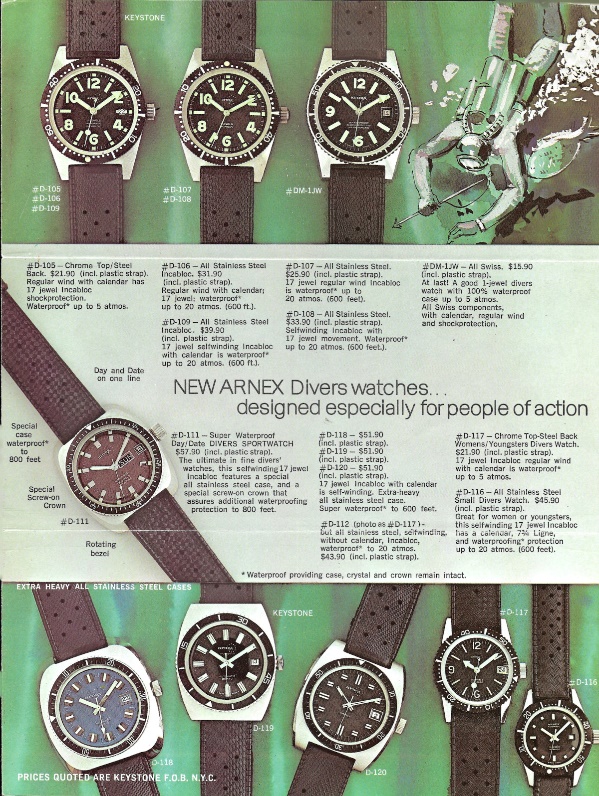
Four-page marketing brochure Figure 12
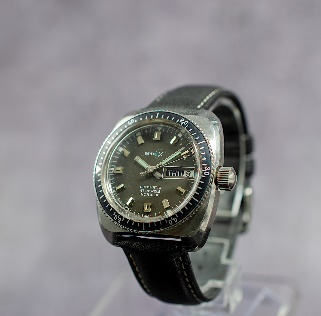

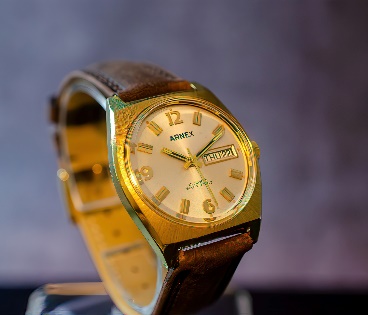
From right to left: A Day Date Diver with a Swiss A Schild 1906 Automatic Movement; a Swiss ETA 2451 Automatic diver; a Swiss A Schild 2066 Automatic Day Date 25 Jewel Men’s Wristwatch.


Figure 16
What Else Did the Jewelry Trade Need?
Running the nation’s only pocket watch supplier required more than a few pocket watches. Arnold Fuchs had a mentor, named Henry B. Fried and plenty of friends, and stacks of historical periodicals with titles such as The Horological Review, the Jewelers’ Weekly and the Jewelers Review. Fuchs had to buckle down and study an old trade supplanted by wristwatches during and after World War I.
From the 1500’s when Peter Henlein invented the mechanical timepiece, through the refinements of Adrien Philippe in 1842, the industry only produced pocket watches. Their end began during World War I, as trench warfare and aviation demanded people strap a watch to their wrists.
Production of pocket watches declined steadily with a slight resurgence during World War II when naval engagements demanded high precision rendezvous. The railroad industry continued the use of pocket watches by conductors and engineers; however, during the 1950’s, wristwatches took the place of railroad pocket watches.
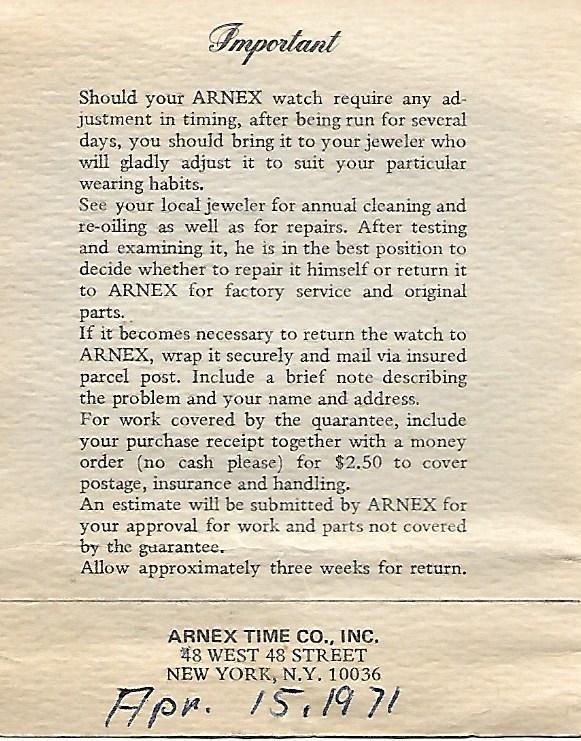
Figure 17 Found with a Kennedy Memorial
Arnex Trademark

Figure 18
What Happened to Repairers?
In 2023, the US Bureau of Labor Statistics estimated that U.S. firms employed about 1800 watch repairers. Compare that number to 1963, when the Saint Louis Fed wrote: “Employment of watch repairmen was estimated to be more than 25,000 in 1963.” They also believed, “employment opportunities will continue to be good through the 1960’s and in the longer run for experienced repairmen who have established reputations for doing high quality work.”
The Saint Louis Fed obviously got it wrong in 1963. A decline from 25,000 repairers then to 1800 today didn’t happen all at once. We touch on how this came about soon. You can call Arnold Fuchs fortunate with regard to his business while he moved from the parts business to pocket watches.
The Swiss Become Engaged
The fashion trends of the 1970’s held and even grew, bringing more vendors into the market to compete with Arnex. Even so, the company did not experience competition from a single brand, but rather, saw competition due to the number of different brands calling on jewelry and department stores with less expensive offerings.
The flagship of Arnex’s line, the hunter case, with a shield in gold and silver, became available through companies such as Bulova under its Caravelle subsidiary. See below:
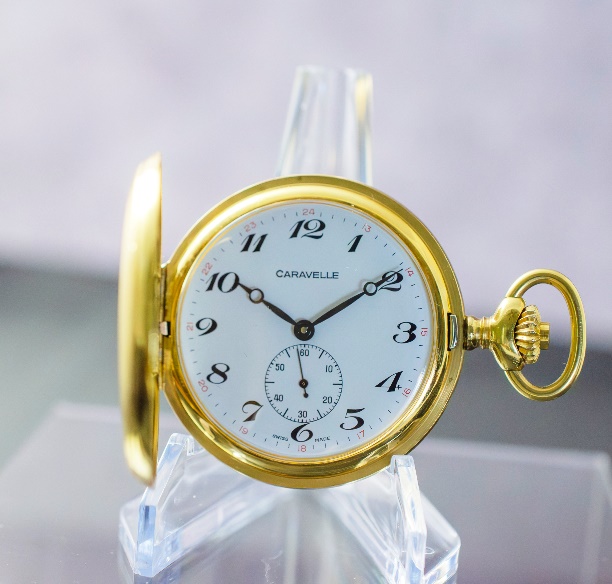
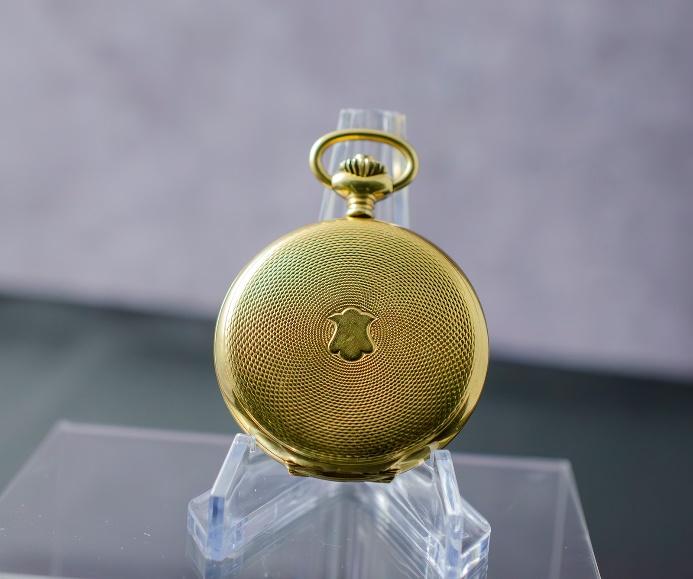
Figure 19 Bulova’s version of the 14 g note the position of the second hand.
With the Bulova name behind it, jewelers had a recognizable brand to show customers looking for gifts if they had never heard of Arnex. While the Caravelle looked like the Arnex, it had a smaller wristwatch movement running the mechanism.
Arnold Fuchs may or may not have sensed changes coming, but the entire industry headed for a major shakeup. Whatever his reasons, Fuchs sold out at the peak and moved south. News of the sell came from the SEC NEWS DIGEST. September 25, 1973:
LCA CORPORATION, Two Decker Sq., Bala Cynwyd, Pa. 19004 – 460,000 of non-assignable rights to contingent deferred cash consideration. It is proposed to issue these rights in connection with the proposed exchange for cash and the assumption of liabilities of the business and assets of Arnex Industries Corp., which would voluntarily dissolve. LCA manufactures and distributes lighting products and housewares, such as electric kitchen appliances and vacuum cleaners. Arnex principally sells pocket and pendant watches and also sells clocks, timers, wrist watches and other items. (File 2-48694 If)
Arnold Fuchs: First-in, First-out of 1970’s Pocket Watch Craze
Pierre-Yves Donze describes the turbulence of the times in his book, A Business History of the Swatch Group, 2014 Palgrave Macmillan. In summary, he wrote that, the Swiss watch industry experienced 40 years of growth. Swiss exports increased from about 24 million watches and movements in 1950 to 84 million by 1974. Then a sudden jolt occurred in the business, in which the Swiss lost 43 thousand jobs between 1974 and 1980, and sales fell to around 30 million from 84 million during the same period. Subsequently Arnex closed its doors in 1982.
What caused the failure of the Swiss watch industry?
A combination of factors including:
- The United States, the largest watch market in the world, experienced a major economic downturn during 1974 through 1975 caused by numerous factors including a shortage of fuel, high inflation, and high interest rates.
- The emergence of Japanese watch manufacturing and their aggressive marketing presence in the U.S. against the Swiss.
- Change in the Bretton Woods global monetary policy that fixed exchange rates among 44 nations with the United States in control of 65% of all global gold reserves. Once the United States ended the fixed exchange rate system, the dollar fell against the Swiss franc by 60%. This made Swiss watches expensive, however it did not affect the Japanese-US exchange rates since they didn’t belong to the Bretton Woods group.
- Technological changes from mechanical to quartz watch movements.
How to Determine Arnex Value
Note: This section applies to Arnex, however, one may find the information useful if looking at competitive brand pocket watches also.
Pocket watches have enjoyed a resurgence in popularity in recent years. During the 1970’s, the three-piece suit fad caused a flow of products from Switzerland. Today’s resurgence began with the Hollywood streaming of a series entitled Peaky Blinders, a British period crime drama running from 2013-2022. Set in Birmingham, it follows the exploits of a crime gang in the direct aftermath of the First World War. The story follows exploits of a real urban youth gang of the same name active in the city from the 1880s to the 1910s.
Like the films of the 1960’s and 70’s, this film created a cultural impact, only today aided by the Internet. Throughout its run, Peaky Blinders received widespread critical acclaim. Netflix acquired exclusive US distribution rights in which the entirety of the series became available for streaming on 30 September 2014.
In August 2020, FuturLab developed a video game based on the television series, titled Peaky Blinders: Mastermind. that they released for Xbox One, PlayStation 4, Nintendo Switch, and for PC via Steam. Maze Theory developed and released a virtual reality game, Peaky Blinders: The King’s Ransom, for Meta Quest 2 and PICO 4 on March 9, 2023.
We cannot ignore the impact of historical events during the existence of Arnex and its popularity in the resale market. Compare Arnex watches on eBay and Pinky Blinder Asian watches on other sites. The Swiss products look superior and resemble watches used in films and streaming services.
Cultural Impact of Hollywood on Purchases
According to the Office for National Statistics (ONS), Peaky Blinders has had a detectable cultural impact in the UK. In 2018, the lead character’s name, Arthur, surged into the top 10 boys’ names for the first time since the 1920s, while Ada jumped into the girls’ top 100 for the first time in a century too. ONS reached the assumption that characters Arthur Shelby Jr. and Ada Thorne inspired the popularity of these names.
Look Out: A different Kind of Pocket Watch
Arnex sold different kinds of watches in 1971 than it did in 1977. Quality changed as a result of the new owners taking control.
For example, one might consider the Medallion-cases with Unitas forty-one-millimeter movements as some of the finest pocket watches ever made. Arnex also offered several other double back cases with the Unitas 6441 movements as market entries. The 18.5’” Open Face Pocket Watch (model 26g) shown above eventually became a collectible series.

Figure 20 -Double Back Open Face Watches with Fired Enamel Porcelain Dials
Arnex brought these to the market with fired enamel porcelain dials and double case backs in gold and silver.
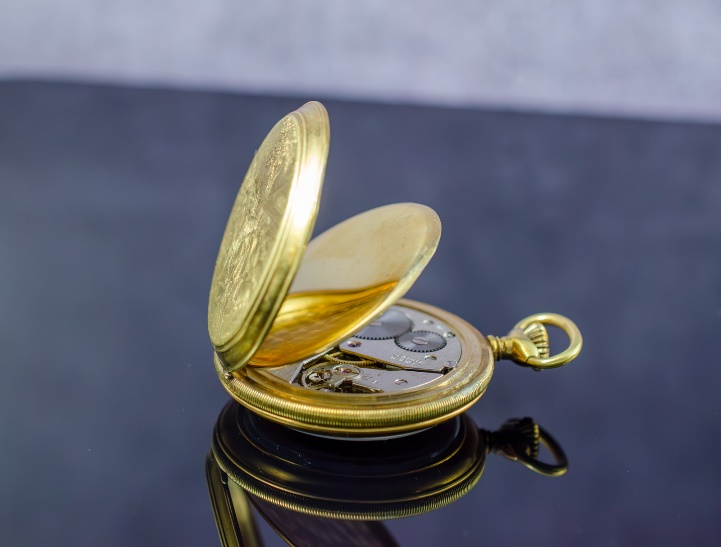
Figure 21 Double Back Case
Once Kidde & Company bought Arnex under the umbrella of LCA Corporation, management changed and an emphasis on profits changed the company’s marketing mix. When looking at Arnex products one needs some clues to decide if a purchase will serve ones intentions.
You need to ask about the movement, the kind of case used and also determine if you’re buying a pocket watch or something resembling one. Did the seller have it serviced, or will you need a repair person?
The better Arnex products came with real pocket watch movements including Unitas 6441/6334 and Unitas 6497 and 6498 caliber pocket watch movements.
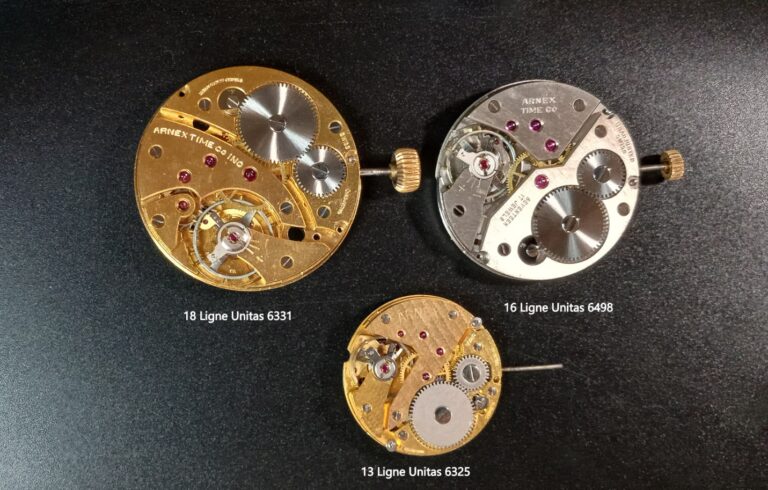
Figure 22 Arnex Pocket Movements
The company sold the remainder of their cases with wristwatch movements. The first photo displayed at the top of this this article has an A Schild 1187/94 wristwatch movements also sold in the watch below.
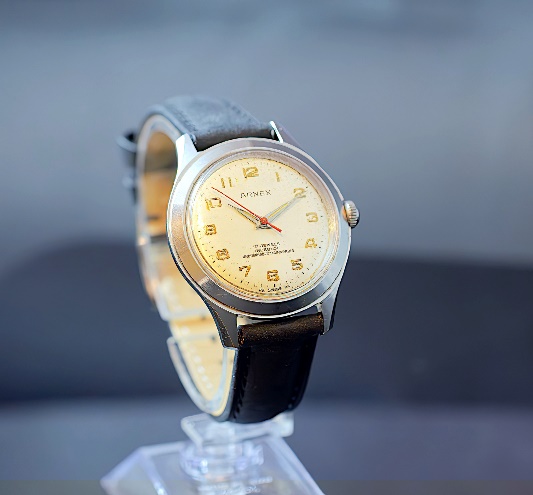

Figures 23 & 24 Arnex Wristwatch and Pocket Watches with A Schild 1187/94 Movements
Let’s Take a Look at The 1977 Catalog
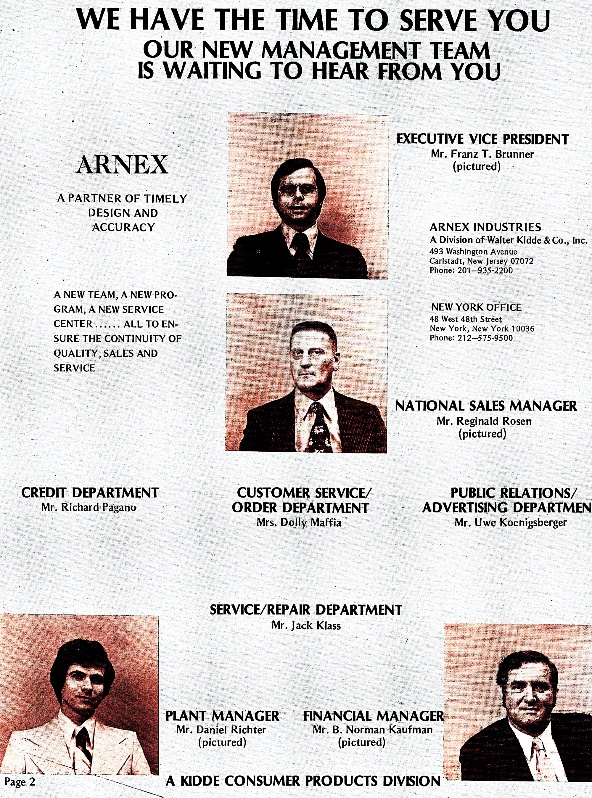
Figure 25
The slogan to the left and center reads: “A new team, a new program, a new service center…all to ensure the continuity of quality, sales and service.” During an interview on August 22, 2023 in Englewood, Florida Dan Richter said this statement had no true substance. In other words, its claims were inaccurate.
Cutting Costs and Hoping No One Noticed
The new team and new program entailed cost and quality reductions. The purchasing department stopped buying watches with high quality Unitas pocket watch movements and began using cases with wristwatch movements. They also began using low-quality cases.

Figure 26 1979 Arnex Pocket Watch Model 184
Before one can grasp the difference in quality, one needs to understand the different ways companies make cases and how the Swiss made movements.
Notice the case immediately above. By the time Arnex had this case made, they resorted to casting, a process by which someone makes a mold, melts metal and pours it into the mold. People will argue for casting in jewelry, but if someone carries a watch in a pocket, it does not hold up well. The high points of the image wear easily.
Initially, Arnex bought stamped cases where someone used a sheet of metal and pressed it into a mold to the desired shape. Some cast cases maintain strength, but they become brittle whereas a stamped case retains its metallurgical properties, and it holds up against wear.
Originally, Arnex bought cases made like coins, where the cast cases were die struck. Good examples of Arnex die-struck cases include the Presidential series, especially the Kennedy memorial watch in Figure 27.
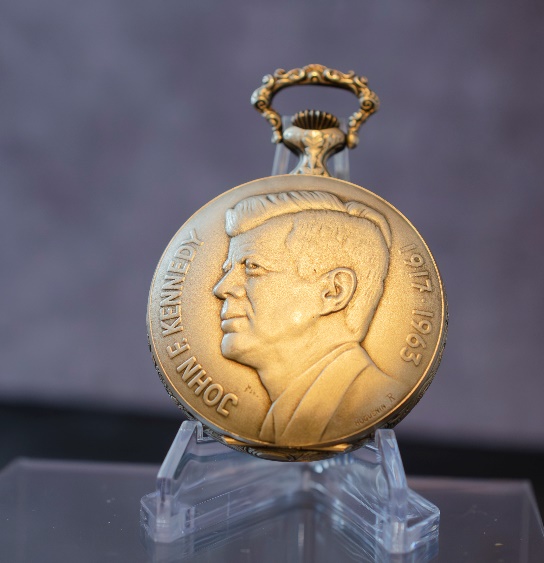
Figure 27 1971 Kennedy Memorial
The case in Figure 26 looks like early Arnex watch cases; however, the manufacturer used inferior metals and cast it to make it resemble a struck or stamped case. It also uses a wire spring to release the cover instead of a solid metal spring.
Look at the catch in the following photo and the placement of the second hand. The second hand sits above the Roman numeral six indicating it uses a wristwatch movement. In addition, the case uses wire, not metal to form the latch which releases the cover when pressing the crown;

Figure 28 Notice with wire latch of the Model 184
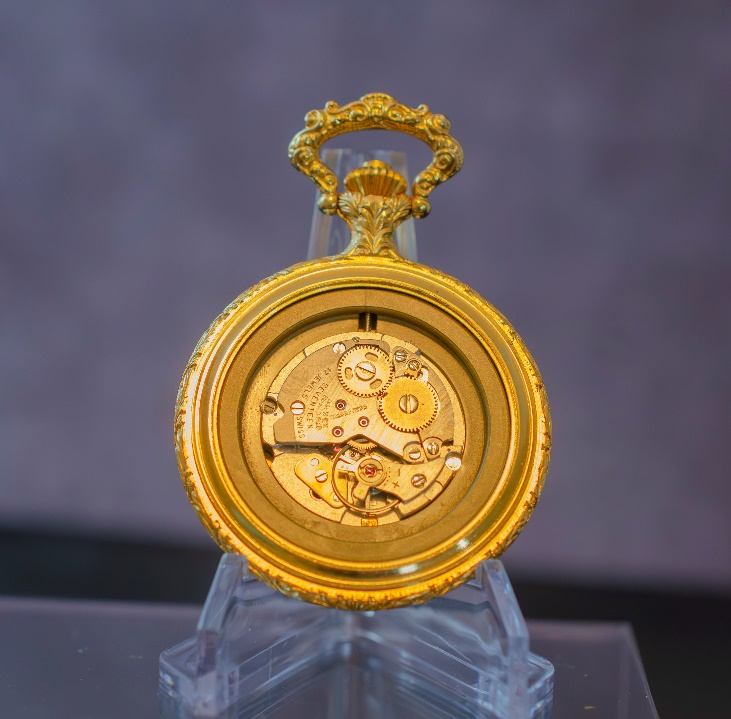
Figure 29 Open Case Back displays a Unitas wristwatch movement in the Model 184
Now, let’s compare this watch to an early Arnex. It has a fired enamel porcelain front, back and inside cover. It has a Unitas 6498 movement.
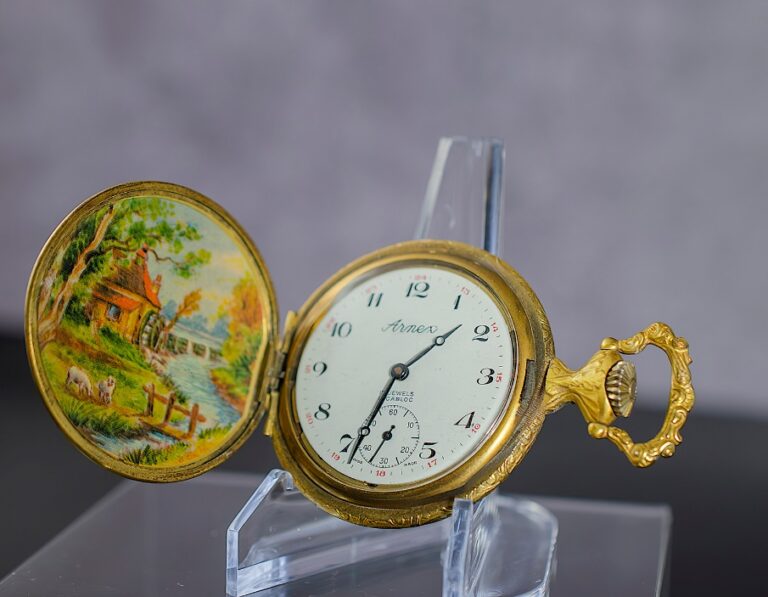
Figure 30 Arnex Model 814 Arabic Dial
Notice in Figure 30 the quality of the latch. It’s not wire. It’s metal. That indicates the case started as a stamped metal case. Look for that type of latch. Also notice the position of the second hand. It’s low on the dial which indicates it has a pocket watch movement instead of a wristwatch movement.
We have two more views of the enamel 814 case and a shot from the catalog used to display it to jewelers.
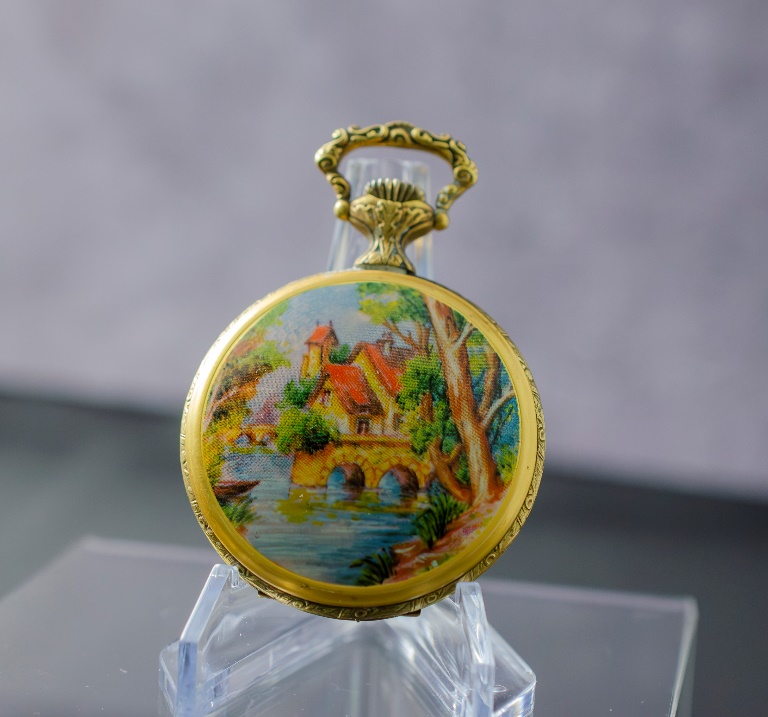
Figure 31 Back Cover of Model 814

Figure 32 Front Cover of Model 814
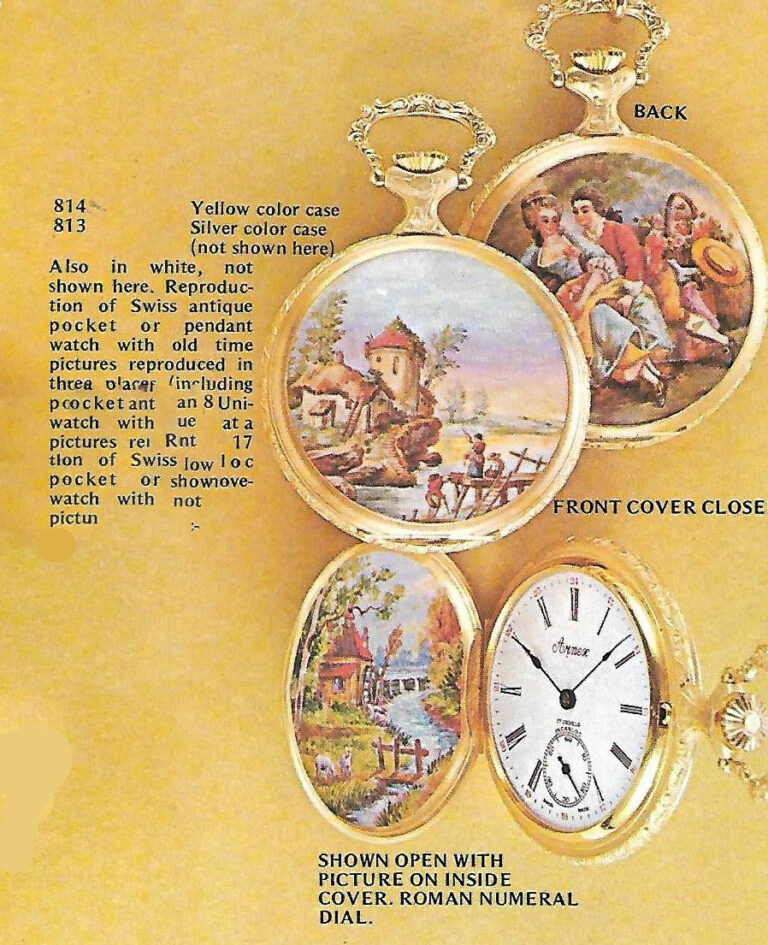
Figure 33 – Snapshot of original Model 814 in Arnex Catalog
As a contrast, look at the fired enamel cases offered in the Kidde Consumer Products Division inspired 1974-75 catalog. The copy reads, “Swiss hunting case watches with covers that have antique reproduction porcelain inlaid with simulated enamel designs….”
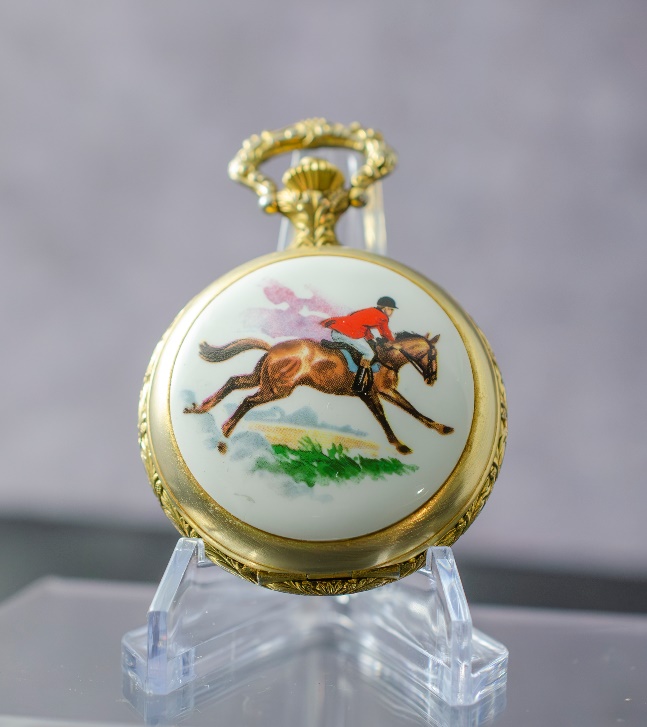
Figure 34 Model 327 Front Cover
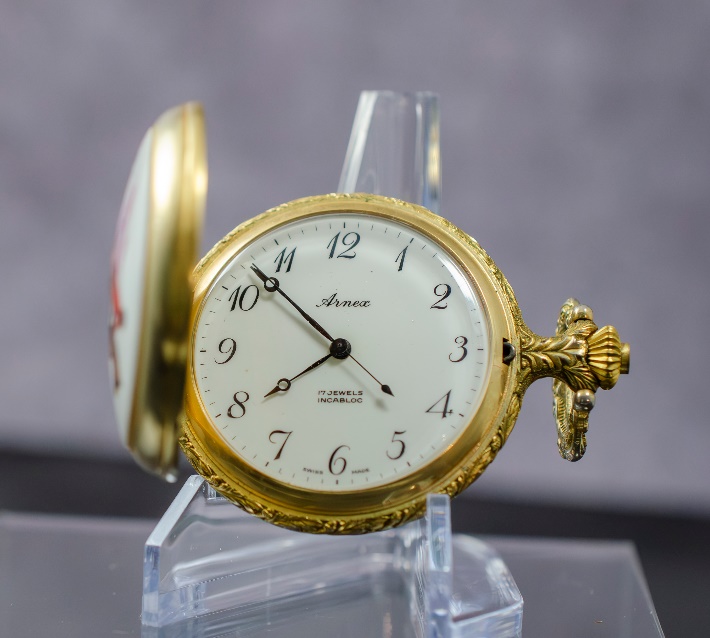
Figure 35 Dial Open Model 327

Figure 36 Opened Back Exposing AS ST 1950/51 Movement
Ten Arnex Watch Models Sold with Wristwatch Movements
The 1974-75 catalog offered 10 models of this watch. As a buyer one should notice several issues. First, the manufacturer glued the so-called fired enamel reproductions to the casted metal case. Recall, that means the case began as poured metal into a mold. Notice the wire latch in Figure 35 and the sweep second hand. That should tell one two things about this watch. First, the wire latch has a wired spring to open and hold the open cover. Secondly, the sweep second hand indicated it has a wristwatch movement.
Cheaper Movements In Pocket Watch Cases
In figure 36, we expose an AS ST 1950/51 movement. In watch terms, we refer to this as a standard Swiss commodity movement made to compete with Seiko of Japan’s manual movement.
When these watches appear on eBay, they usually ask $100 or more for them. I bought three to analyze. The movements sell used for about $40-50 for parts.
For Sellers of Arnex Pocket Watches
We realize that sellers have little to no knowledge of Swiss watches from the 1970’s. I have purchased Arnex watches for as little as $10 and as much as $130. The higher priced watches have Unitas 16 & 18 size movements. The cases usually have stamped cases.
I buy the watches with Unitas movements because The Swatch Group Ltd. bought Unitas and adapted them to create their ETA 6497-1 and 6497-2 movements. We cannot buy those movements and must resort to finding used ones. Arnex pocket watches often provide one of the only sources for the size 16 movements.
Fifty-year-old watches needs servicing. The lubricants in use during the 1970’s degrade and cause the movements to run poorly or fail.
Sellers often find an Arnex in a hunter case and ask as much as $500 for it. Consider that delusional. Remember, a watch manufacturer may want a used Unitas movement, but if he or she cannot service the watch, then they have to find a repair person to clean, oil and adjust the movement. The cost for that can run from $100 to $300 on average plus parts.
The larger 18 size Unitas movement presents another problem. Unless someone has a case to fit it, it makes little sense to buy one. Watches like those mentioned above and listed for hundreds of dollars usually sit unsold for years.
Arnex models with wristwatch movements have little value. They break down within weeks to months. Asking $125 for a square Arnex watch with a one jewel Baumgartner movement means you either paid too much for it or one wants a buyer to pay too much for it. Think of it as a 1960-1970 wristwatch on a chain that needs servicing.
Summary: Arnex Buying and Selling Contributions
Arnex Industries Corp, Arnex Time Co. and its related association did offer pocket watches to the trade when American brands stopped making them. As described in its 1971 four-page brochure, they had the most complete selection of pocket watches in the nation. People list their watches on the resale marketplace.
If looking for a better watch than what Asians offer today, one should consider them with only the Unitas movements worthy of consideration. Also, look for stamped cases, preferably with double backs.
All the best!
Citations:
- Arnex Industries Corp 2-42470 05 Industry 509: Wholesale Trade -Miscellaneous Wholesalers 8K -2-42470-2. Citation: Directory of Companies Filing Annual Reports with the Securities by United States. Securities and Exchange Commission, Office of Policy Research SECURITIES ACT REGISTRATIONS. Effective May 4. Arnex Industries, Corp., 2-42470 (90 days); Securities and Exchange Commission News Digest May 9, 1972.
- National Watch and Clock Collectors Association Horological Education Watches European/Other Pocket Watches 176936/#post-1613875
- Ligne used in watch caliber measurements. A ligne equals 2.2558 mm.
Acknowledgements
Many thanks go to Dan Richter for his contribution to the entire industry. To Carlos Wayne Wilson (Author) for his editorial work on this on this article. I find it a joy to have such a remarkable historian as a friend. To Ted Tongson, TheWatchDoc, my mentor and a contributor to this article. To Sam, Xu Wei Hao, for his artwork, consultation and knowledge of horology.
About the author. Tom Adelstein is an award-winning author and journalist based in the United States.